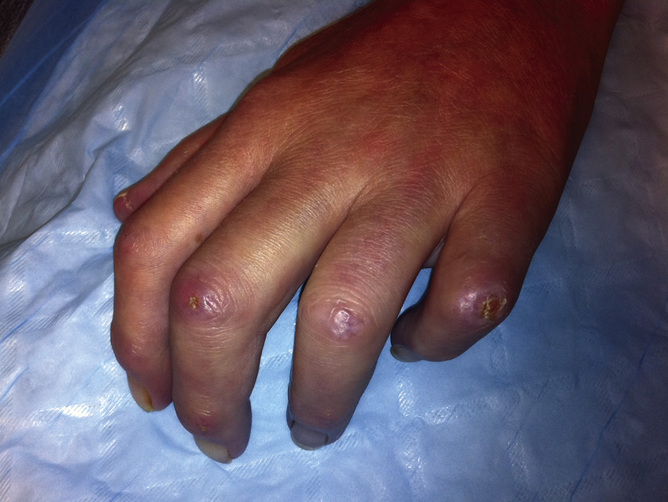R. Michelle Koolaee RP is an exaggerated response of the digits to cold temperatures and is characterized by distinct color changes of the skin of the digits. It is thought to be due to an abnormal vascular response, causing vasoconstriction of the digital arteries and cutaneous arterioles. An attack of RP classically manifests as a triphasic color change, white to blue to red. RP is considered primary if not associated with an underlying disease (i.e., many young, thin females who are long-distance runners have primary RP; this is usually benign) and secondary RP if it is associated with a connective tissue disease. There is no standardized way to elicit a history of true RP. The author prefers these screening questions: • Are your fingers unusually sensitive in places such as the frozen food section of the grocery store? What can be very helpful for the clinician is for the patient to take photographs of the digits during an episode of RP and show this to you during the visit (see Fig. 23.1). Table 23.1 describes clinical differences between diffuse and limited SSc. TABLE 23.1 Limited Versus Diffuse Systemic Scleroderma Table 23.2 describes the cutaneous manifestations of SSc. Figure 23.2 demonstrates a patient with sclerodactlyly and resolving skin ulcerations, most prominent at the third and fifth proximal interphalangeal joints. Figure 23.3 demonstrates classic “salt and pepper” skin changes seen in SSc. TABLE 23.2 Cutaneous Manifestations of Scleroderma Dyspnea in a patient with SSc should always prompt evaluation. Pulmonary involvement is seen in more than 70% of patients with SSc; the most common pulmonary manifestations include interstitial lung disease (ILD) and pulmonary vascular disease, leading to pulmonary arterial hypertension (PAH). PAH is amenable to medical management; this should be assessed for initially with a transthoracic echocardiogram (TTE). However, echocardiograms give both false-negative and false-positive results; right heart catheterization is essential to confirm the diagnosis and exclude other disease processes. Often severe and progressive, PAH can lead to cor pulmonale and right-sided heart failure.
A 58-Year-Old Female With Dyspnea on Exertion and Renal Failure
What are helpful ways to elicit a history of RP?
How is diffuse SSc distinguished from limited SSc?
Features
Limited Scleroderma
Diffuse Scleroderma
Sclerodactyly
Distal to the wrists; spares the face and neck
Proximal to the wrists and knees; also affects the face, neck, and trunk
Raynaud’s phenomenon
May be evident years before other features of limited SSc
RP and skin changes often occur closely together in time
Morbidity
PAH is more common in limited disease; the severity of PAH is correlated with the risk of premature death
Greater risks for renal (SRC), lung (ILD), and cardiac disease (pericardial/myocardial disease)
Other
Prominent vascular manifestations; may be classified as having the CREST syndrome (Calcinosis cutis, Raynaud phenomenon, Esophageal dysmotility, Sclerodactyly, and Telangiectasia)
May also have vascular manifestations
What skin changes are seen in patients with SSc?
Skin Finding
Description
Sclerodactyly
Usually begins in the fingers, hands, and face; variable in extent and severity
Nail-bed abnormalities
Dilated and tortuous nail-fold capillaries alternating with capillary dropout; cuticular overgrowth
Skin pigment changes
“Salt and pepper” appearance of the affected skin due to areas of hypopigmentation alternating with areas of hyperpigmentation
Digital ulceration
As a result of severe skin thickening (resulting in skin breakdown) and/or poor peripheral circulation
Telangiectasias
Small dilated blood vessels near the surface of the skin; more frequently a feature of limited scleroderma
Calcinosis cutis
Soft tissue calcifications; more frequently a feature of limited scleroderma
Edema of the hands
Edematous swelling and erythema may precede skin induration; this may be associated with pruritus of the skin
What are possible causes of this patient’s dyspnea?
23 A 58-Year-Old Female With Dyspnea on Exertion and Renal Failure
Case 23






